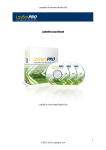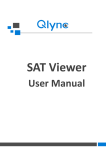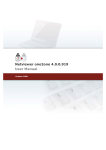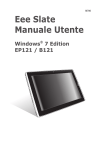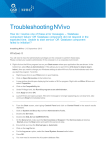Download Windows 7 User Guide
Transcript
Windows 7 User Guide IT HELPS YOU Contents Taskbar .......................................................................................................................................................... 3 Jump Lists .................................................................................................................................................. 3 View the Jump List for a program ......................................................................................................... 3 Open an item from a Jump List ............................................................................................................. 3 Pin an item to a Jump List ..................................................................................................................... 3 Unpin an item........................................................................................................................................ 3 Peek........................................................................................................................................................... 4 Temporarily preview the desktop ......................................................................................................... 4 Minimize open windows so that they remain minimized..................................................................... 4 Preview open files ................................................................................................................................. 4 Snipping Tool................................................................................................................................................. 5 Use Snipping Tool to capture screen shots ............................................................................................... 5 To capture a snip ................................................................................................................................... 5 To capture a snip of a menu ................................................................................................................. 6 To annotate a snip ................................................................................................................................ 6 To save a snip ........................................................................................................................................ 6 To share a snip ...................................................................................................................................... 6 Gadgets ......................................................................................................................................................... 6 Add gadgets .............................................................................................................................................. 6 Configure gadgets ..................................................................................................................................... 6 Close gadget .............................................................................................................................................. 7 Windows Search ........................................................................................................................................... 7 Use the search box on the Start menu ..................................................................................................... 7 Use the search box in a folder or library ................................................................................................... 8 Snap (Window Docking) ................................................................................................................................ 9 Arrange windows side by side ................................................................................................................ 10 Maximize a window ................................................................................................................................ 10 Shake ........................................................................................................................................................... 10 Minimize windows using Shake .............................................................................................................. 10 Wireless Access ........................................................................................................................................... 10 Timken Wireless ...................................................................................................................................... 10 Home Wireless ........................................................................................................................................ 10 Projectors and External Monitors ............................................................................................................... 11 Activate projector/external monitor ...................................................................................................... 11 Disconnect projector/external monitor .................................................................................................. 11 Windows Mobility Center ........................................................................................................................... 11 Brightness ............................................................................................................................................... 11 Volume .................................................................................................................................................... 12 Battery Status.......................................................................................................................................... 12 Screen Rotation (Tablets only) ................................................................................................................ 12 External Display....................................................................................................................................... 12 Presentation Settings .............................................................................................................................. 12 7-Zip (like WinZip) ....................................................................................................................................... 12 Unzip ....................................................................................................................................................... 12 Zip............................................................................................................................................................ 12 View ZIP Contents (without extracting) .................................................................................................. 12 Password Expiration Notification................................................................................................................ 13 Hotkeys ....................................................................................................................................................... 14 2|Page Taskbar Jump Lists Jump Lists on the taskbar give you quick access to the things you use most often. View the Jump List for a program Right-click a program's button on the taskbar. Open an item from a Jump List Open the program's Jump List, and then click the item you wish to start. Pin an item to a Jump List Open the program's Jump List, point to the item and click the pushpin icon. Notes: Folders are considered Windows Explorer items, and appear in the Windows Explorer Jump List when pinned or opened. Unpin an item Open the program's Jump List, point to the item and click the pushpin icon. Notes: The next time you open an item that you've unpinned, it might reappear in the Jump List. To remove an item from the list, right-click the item and then click Remove from this list. 3|Page Peek You can temporarily view the desktop using Peek. This can be useful for quickly viewing desktop gadgets and folders, or when you don’t want to minimize all open windows and then have to restore them later. Temporarily preview the desktop 1. Point to the Show desktop button at the end of the taskbar. The open windows fade from view, revealing the desktop. 2. To make the windows reappear, move the pointer away from the Show desktop button. Minimize open windows so that they remain minimized 1. Click the Show desktop button. 2. To restore the open windows, click the Show desktop button again. When you open multiple windows on the desktop, it can sometimes be a challenge to view separate windows and switch between them. You can use Peek to take a quick look at other open windows without clicking away from the window you're currently working on. Peek makes it easy for you to preview the contents of open windows and switch to the one you want. Preview open files 1. Point to a program button on the taskbar that has open file(s). 2. Point to a thumbnail. All other open windows temporarily fade away to 4|Page reveal the selected window. 3. To preview a different window, point to a different thumbnail. 4. To restore your desktop view, move the pointer away from the thumbnails. Tip: To open the window you're previewing, click the thumbnail. Snipping Tool The Snipping Tool captures a screen shot of anything on your desktop, like a picture or a section of web page. Snip a whole window, a rectangular section of the screen, or draw a freehand outline with your mouse or tablet pen (or your finger, if you're using a PC with a touchscreen). Then you can annotate, save, or email the image using the buttons in the Snipping Tool window. Use Snipping Tool to capture screen shots You can use Snipping Tool to capture a screen shot, or snip, of any object on your screen, and then annotate, save, or share the image. You can capture any of the following types of snips: Free-form Snip. Draw a free-form shape around an object. Rectangular Snip. Drag the cursor around an object to form a rectangle. Window Snip. Select a window, such as a browser window or dialog box, that you want to capture. Full-screen Snip. Capture the entire screen. After you capture a snip, it's automatically copied to the Clipboard and the mark-up window. From the mark-up window, you can annotate, save or share the snip. The following procedures explain how to use the Snipping Tool. To capture a snip 1. Open the Snipping Tool by clicking the Start button and then, in the list of results, click Snipping Tool. . In the search box, type Snipping Tool 5|Page 2. Click the arrow next to the New button, select Free-form Snip, Rectangular Snip, Window Snip, or Full-screen Snip from the list, and then select the area of your screen that you want to capture. To capture a snip of a menu If you want to capture a snip of a menu, such as a drop-down menu, follow these steps: 1. Open Snipping Tool by clicking the Start button . In the search box, type Snipping Tool and then, in the list of results, click Snipping Tool. 2. After you open Snipping Tool, press Esc, and then open the menu that you want to capture. 3. Press Ctrl + Print Screen (PrtScn). 4. Click the arrow next to the New button, select Free-form Snip, Rectangular Snip, Window Snip, or Full-screen Snip from the list, and then select the area of your screen that you want to capture. To annotate a snip After you capture a snip, you can write and draw on or around the snip in the mark-up window. To save a snip 1. After you capture a snip, click the Save Snip button in the mark-up window. 2. In the Save As dialog box, enter a name for the snip, choose a location where to save the snip, and then click Save. To share a snip After you capture a snip, click the arrow on the Send Snip button, and then select an option from the list. Gadgets Gadgets put useful information at your fingertips. Add gadgets 1. 2. 3. 4. Right-click on the desktop. Select Gadgets. A list of gadgets will appear. Double-click a gadget to add it to the desktop. Configure gadgets 1. Hover the mouse over the gadget. 6|Page 2. Select the Options button that appears. 3. A configured window will appear. 4. Make your changes and select OK. Close gadget 1. Hover over the gadget. 2. Select the Close (X) button that appears. 3. The gadget will then disappear from the desktop. Windows Search Windows provides several ways to find files and folders. There isn't one best way to search—you can use different methods for different situations. Use the search box on the Start menu You can use the search box on the Start menu to find files, folders, programs, and e-mail messages stored on your computer. To find an item using the Start menu: Click the Start button , and then type a word or part of a word in the search box. 7|Page As you type, items that match your text will appear on the Start menu. The search results are based on text in the file name, text in the file, tags and other file properties. Note: When searching from the Start menu, only files that have been indexed will appear in search results. Most files on your computer are indexed automatically. Use the search box in a folder or library Most often you look for a file that you know is in a particular folder or library, such as Documents or Pictures. Browsing for the file might mean looking through hundreds of files and subfolders. To save time and effort, use the search box at the top of the open window. The search box filters the current view based on text that you type. The search looks for text in the file name and contents and in the file properties, such as in tags. 8|Page In a library, the search includes all folders included in the library as well as subfolders within those folders. To search for a file or folder by using the search box: Type a word or part of a word in the search box. As you type, the contents of the folder or library are filtered to reflect each successive character you type. When you see the file that you want, stop typing. Example: Suppose your Documents library looks like this: Now, suppose that you're looking for your invoice files, so you type "invoice" in the search box. As you type, the view is automatically filtered and you see something like this: Snap (Window Docking) You can use Snap to arrange windows side by side, which is helpful when comparing two documents or moving files from one place to another. Also, Snap can maximize a window, making it easier to focus on that window instead of other open windows. 9|Page Arrange windows side by side 1. Drag the title bar of a window to the left or right side of the screen until an outline of the expanded window appears. 2. Release the mouse to expand the window. 3. Repeat steps 1 and 2 with another window to arrange the windows side by side. To return the window to its original size, drag the title bar away from the top of the desktop and then release. Maximize a window 1. Drag the title bar of the window to the top of the screen. The window's outline expands to fill the screen. 2. Release the window to expand it to fill the entire desktop. To return the window to its original size, drag the title bar of the window away from the top of the screen. Shake You can use Shake to quickly minimize every open window except the one you're shaking. This feature can save you time if you want to focus on a single window without minimizing all your other open windows one by one. You can then restore all of those windows by shaking the open window again. Minimize windows using Shake 1. For the window you want to keep open, drag (or shake) the title bar back and forth quickly. 2. To restore the minimized windows, shake the open window again. Wireless Access The following section describes how to access Timken and home wireless networks using your Windows 7 computer. Note: If the Turn Wireless On button on the Wireless Network tile is unavailable, you may need to use the hardware switch on your computer to turn on the wireless adapter. Timken Wireless Laptops are setup with ThinkVantage Access Connections which manages the wireless connections. A Timken laptop will automatically connect to the Timken wireless anytime it is disconnected from a docking station or network cable. No VPN connection is required! Home Wireless To setup your home wireless connection, use the procedure below. Once set up, your computer will automatically connect to your home wireless. 10 | P a g e 1. 2. 3. 4. 5. Press Fn + F5. Select Find Wireless Network. Select your home wireless network. Select the Connect button (bottom-right). Change the Location Name to something relevant – i.e., Home. a. Note: If your wireless network is password protected you’ll need to select the Security Type and provide the password. 6. Select the Save button. Projectors and External Monitors You can use Presentation feature to interact with a projector or external monitor. Activate projector/external monitor 1. Connect the projector/external monitor to your computer. 2. Press Windows + P. 3. Click the appropriate mode: Duplicate, Extend or Project only. Disconnect projector/external monitor 1. Press Windows + P. 2. Click Disconnect Projector. 3. Disconnect the video cable. Windows Mobility Center With Windows Mobility Center, you can quickly access your mobile PC settings in one convenient location. To open the Windows Mobility Center press Windows + X. Brightness Move the slider to temporarily adjust the brightness of your display. To adjust the display brightness settings for your power plan, click the icon on the tile to open Power Options in Control Panel. 11 | P a g e Volume Move the slider to adjust the speaker volume of your mobile PC or select the Mute check box. Battery Status View how much charge remains on your battery or select a power plan from the list. Screen Rotation (Tablets only) Change the orientation of your Tablet PC screen, from portrait to landscape, or vice versa. External Display Connect an additional monitor to your mobile PC or customize the display settings. Presentation Settings Adjust settings, such as the speaker volume and disable the screensaver, for giving a presentation. 7-Zip (like WinZip) 7-Zip is a free third-party tool installed on all Windows 7 computers. This tool provides the ability to unzip and zip files to and from a variety of formats. 7-Zip usage is described below. Unzip 1. Right-click on a zipped file. 2. Select 7-Zip > Extract to… 3. A new folder will be created in the directory, which contains the unzipped content. Zip 1. 2. 3. Right-click on the file or folder you wish to zip. Select 7-Zip > Add to… A new ZIP file will be created in the directory, which contains the zipped content. View ZIP Contents (without extracting) 1. Double-click on a zipped file. 2. The 7-Zip File Manager window will display the content of the zipped file. 3. Browse the files as needed. 12 | P a g e a. Note: You may open files by double-clicking on them, but it is recommended that you unzip the content before modifying data. Password Expiration Notification Windows XP displays the password expiration warning when the 14 day limit is reached. Windows 7 has shortened the password limit to five days. Additionally, a prompt will not appear during the login process. Instead, a notification will display in the system tray by the clock. To change your password, use the following procedure: 1. 2. 3. 4. 5. Press Ctrl + Alt + Delete. Select Change a password… Type your current password. Type your new password twice. Press Enter. 13 | P a g e Hotkeys In the table below, functions and associated hotkeys are listed. Function Show desktop Switch window Open taskbar application Activate taskbar application Snap left Snap right Maximize Restore/Minimize Switch window to next monitor Open Run Open Computer Open Windows Search Open Mobility Center Open System Properties Open application as administrator Open Start menu Open Task Manager All windows transparent Display presentation options Lock computer Hotkey Windows + D Alt + Tab Windows + Shift + [NUM]1 Windows + [NUM]1 Windows + Left arrow Windows + Right arrow Windows + Up arrow Windows + Down arrow Windows + Shift + Right arrow Windows + R Windows + E Windows + F Windows + X Windows + Pause Ctrl + Shift + Left click Windows Ctrl + Shift + Esc Windows + Space Windows + P Windows + L Windows + Tab Windows + Shift + Left arrow Ctrl + Esc Fn + F7 1 Where [NUM] is a number (1 – 9) associated with the applications pinned to the taskbar. The left-most application on the taskbar is equal to 1. 14 | P a g e














